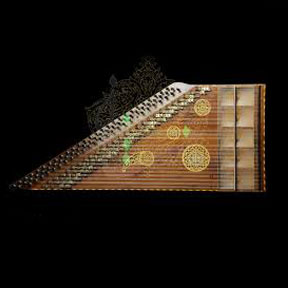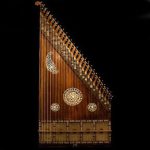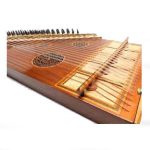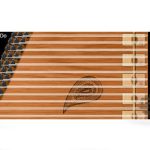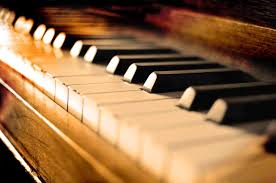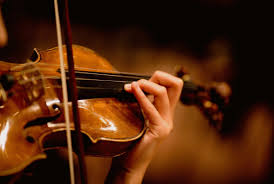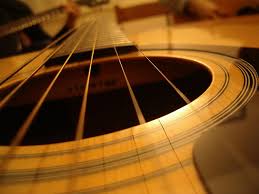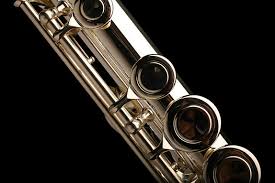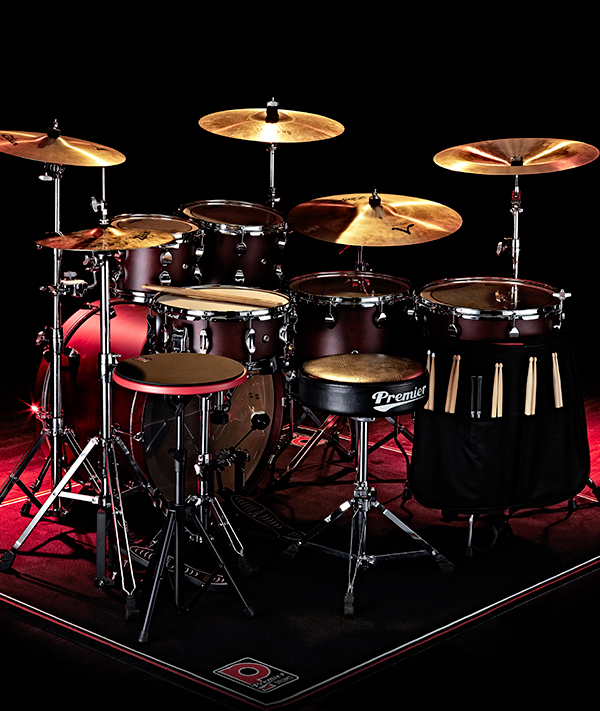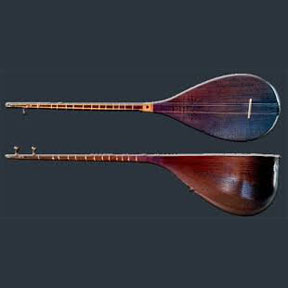History:
The Qanun is a trapezoidal, right-angled, plucked string instrument made from wood, skin, metal, bone, and gut. The musician plays the Qanun seated, with the larger side facing the player and placed on a table or lap. The instrument is played with the thumb and index fingers of both hands, which are fitted with plectrums. The Qanun has a long history and is usually made from aged, sturdy wood, and like other traditional instruments, it is crafted in various sizes with different structural details.
Physical Structure:
Sound Box:
The sound box of the Qanun consists of two wooden panels (top and bottom) connected by four side ribs. This box is typically made of walnut wood.
Top Board:
The top board is wooden and features 27 tuning pegs and 81 strings on its left side. On the right side, under the bridge, instead of wood, there is a rectangular piece of skin approximately 15 cm wide and 40 cm long. The skin-covered part of the top board may be made from a single piece of skin or four separate pieces arranged in square or diamond shapes. The wooden part of the top board has wooden grilles to allow sound to escape.
Skin:
The skin covering the top board is made from camel, calf, or fish skin. The skin needs to be thicker than that used in other instruments to withstand the tension of the 81 strings over a large surface.
Tuning Pegs:
These are small metal devices located on the left side of the Qanun, mounted on a wooden strip attached to the top board. Each tuning peg adjusts the pitch of multiple strings. Tuning pegs come in two types:
Arabic Style: These have a small handle for adjustment and typically range from four to five pegs per string group.
Sliding Tuning Pegs: These have a wooden base on the left side of the Qanun and a small wooden or metal handle that slides along the base to adjust the string length and pitch.
Bridge:
The bridge is a narrow wooden strip approximately 35 cm long (slightly shorter than the width) and about 2 cm high. It is positioned on the right side of the skin-covered area, supporting all the strings and preventing them from embedding into the bridge wood. It features 81 grooves through which the strings pass. The bridge is supported by four small wooden legs on the skin-covered surface.
Tuning Pegs:
The tuning pegs are wooden and shaped like small pyramids. One end is pointed and is embedded in the horizontal wood on the left side of the Qanun. Each string is attached to a peg.
Tuning Key:
A metal tool approximately 10 cm long, with a hole at one end to fit the tuning pegs. The other end is wider and used to turn the strings left and right for tuning.
Bridges:
Inside the sound box, there are usually three bridges (one between the skin-covered and wooden parts of the top board and two underneath the wooden part). They control the pressure on the top board, preventing it from warping and affecting the sound balance between the strings.
Pegs:
A narrow wooden piece located between the tuning pegs and the strings on the left side. Strings pass over this peg to reach the tuning pegs. Some Qanuns have a single peg, while others have multiple small pieces.
String Holder:
The string holder or “resonance box” in the side rib connects the top and bottom boards and is hollow with occasional movable parts. The string knots are placed here and emerge through holes, passing over the bridge.
Number and Type of Strings:
The Qanun typically has 82 strings made of gut, silk, or nylon. In the bass section, metal-wrapped strings are used, usually grouped in threes or pairs. The total number of notes is generally 27, though the number of strings may vary with the size of the sound box.
Range:
The common range of the Qanun in Iran is approximately three and a half octaves.
String Tuning:
The tuning of the strings can be adjusted using the tuning pegs to cover all intervals of traditional music (from flat to sharp).
Notation:
Notation for the Qanun is written on two staves. The notes within one octave and in the bass range are written in the F clef on the fourth line, while the rest are written in the G clef on the second line.
Plectrum:
The plectrum is a relatively wide metal ring made of silver, brass, or bronze that fits on the second joint of the index finger. Inside the ring, there is a blade made of cow, deer, or mountain goat horn (or sometimes soft plastic) used for plucking the strings.
Other Features:
The presence of tuning pegs allows for playing all intervals of traditional music.
Multiple chords can be played simultaneously (up to six notes).
The Qanun is used for both solo and ensemble performances.
Various techniques such as glissando, pizzicato, trill, and passage work can be executed on the Qanun.
In Iranian Qanun playing, a small plectrum is used to maintain the timing of the notes.
The Qanun is also used in other countries, such as Egypt, Turkey, and Armenia, with different sizes and ranges.
Specific conventional symbols for finger use and various musical techniques are employed for this instrument.
Single-handed plectrum techniques are also possible on this instrument.

